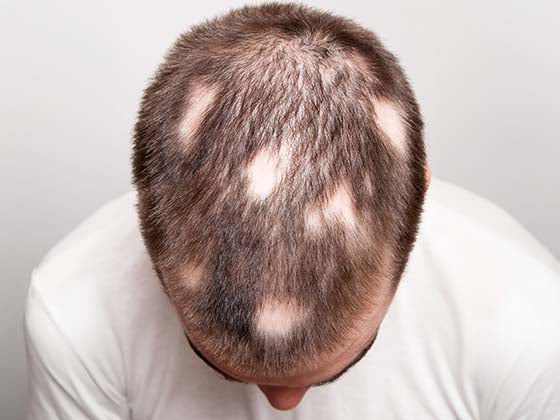Hair extensions can be a great way to add volume and length to thinning hair, but they do come with certain risks. In this blog, we will study five risks to consider before opting for hair extensions.
Understanding Hair Extensions and Their Impact on Hair Health

Hair extensions can be a great way to temporarily enhance your look, but they require proper care and attention to avoid damaging your natural hair. By understanding the risks and following the right maintenance routine, you can enjoy the benefits of extensions without compromising hair health. If you’re unsure, always consult with a professional stylist to determine the best approach for your hair type and health.
The Science Behind Hair Extensions: How They Affect Your Scalp

The health of your scalp is closely linked to the health of your hair. Scalp health can affect hair growth, thickness, and overall quality. A healthy scalp is typically well-hydrated, free of buildup, and has good circulation. When you apply hair extensions, it's important to consider these factors to ensure the health of your scalp is maintained.
-
Blood circulation: Proper circulation is required for optimal hair growth. The scalp is densely packed with blood vessels that provide nutrition to hair follicles as they grow. Tight extensions produce tension, which can restrict circulation and have an influence on hair health.
-
Oil Production: Your scalp generates oils that preserve and nurture your hair, sometimes making oily scalp. When you wear extensions, particularly those that completely cover your scalp, these oils may not be able to reach the roots as effectively. This can cause dry scalp or irritation in rare circumstances.
Traction Alopecia: A Real Risk with Hair Extensions

Traction alopecia occurs when hair is pulled too firmly or persistently for an extended length of time, causing significant strain on the hair follicles. This strain can cause hair to thin and finally fall out. If not treated promptly, the hair follicles may get damaged over time, resulting in permanent hair loss. Hair extensions, whether clip-in, tape-in, sew-in, or fusion, add weight and strain to your original hair. If the extensions are put excessively firmly or kept in for too long, they can strain on the scalp and hair, increasing the likelihood of traction alopecia.
-
Tight application: Tightly applied extensions can put a lot of strain on the hair follicles. This is especially true with sew-in weaves or fusion bonds, in which the extensions are linked with beads, threads, or glue, causing tugging on your original hair.
-
Heavy Extensions: Extensions that are excessively heavy for your natural hair might cause traction alopecia since the extra weight puts additional pressure on the scalp. This is especially true when wearing huge, thick extensions for an extended period of time.
-
Constant Use: Wearing extensions without allowing your natural hair to rest will raise your chances of developing traction alopecia. If your scalp and hair are constantly stressed without rest, hair loss is unavoidable.
Common Types of Hair Extensions and Their Damage Potential

The most common types of hair extensions and their potential for damage:
-
Clip-in hair extensions: Clip-in hair extensions are temporary and easy to apply and remove. They are made of hair strands linked to little clips that snap into place along your natural hair.
-
Tape-in hair extensions: Tape-in hair extensions attach portions of hair to your natural hair using adhesive tape. The extensions are put between layers of your natural hair and are semi-permanent, lasting around 6-8 weeks before requiring a touch-up.
-
Sew-in (Weave) hair extensions: Sew-in extensions involve braiding the natural hair into cornrows, and the extensions are sewn into the braids using a needle and thread. This method is often used for thicker hair types, and it can last several weeks to a few months.
-
Fusion or keratin bonded extensions: Fusion hair extensions, also known as keratin bonded extensions, attach small chunks of hair to your natural hair using a keratin-based glue. Heat softens the keratin, and the extensions are fused to your hair strand by strand, resulting in one of the most flawless and long-lasting procedures.
-
Micro-link extensions: Micro-link extensions join small portions of hair to natural hair with tiny beads or links. The natural hair is threaded through the bead, and the extension is securely clamped into place. This procedure is semi-permanent and usually lasts a few months.
-
Wigs: Wigs are a completely new way to add volume and length to your hair. They are constructed of synthetic or human hair and can be used as a complete cover for your natural hair. Wigs are commonly worn for fashion or to mask hair loss.
The Hidden Dangers of Using Hair Extensions for Thinning Hair

Hair extensions can be an enticing alternative for those with hair thinning, since they provide a rapid way to increase volume and length. While extensions may give a short cosmetic fix, they can also provide hidden risks that, if not utilized correctly, might deteriorate the condition of your natural hair. Some of the major risks and hidden dangers of using hair extensions for thinning hair include traction alopecia, breakage and weakening of natural hair, and scalp irritation and inflammation, slower hair growth and folicle damage, product and dirt accumulation, lack of moisture and hydration for natural hair, difficulty in proper removal, and psychological effects of extension dependency.
Increased Hair Breakage: Why Extensions Weaken Natural Hair

While hair extensions might be a temporary remedy for thinning or fine hair, they can also cause hair breakage if not applied or cared for correctly. Some procedures involve strain, weight, heat, and glue to weaken already fragile hair, resulting in breakage, thinning, or even permanent hair loss. To avoid damage, select the appropriate extensions for your hair type, install them with minimal tension, and give your natural hair regular breaks from additions. Maintaining a healthy scalp and regular hair hydration will also help your natural hair stay thick and robust. Always consult a professional hairdresser before applying or removing extensions to reduce the risk of breakage and keep your hair healthy.
Scalp Irritation and Allergic Reactions: What You Should Know

Scalp irritation
-
One of the most common reasons for scalp irritation is the tightness of the extensions. Sew-ins, braids, and micro-link beads are frequently applied with high tension to keep them in place. The continual pushing on the hair follicles can cause discomfort, redness, and irritation.
-
If the extensions are applied too firmly or incorrectly, the scalp may experience extra friction and stress. Furthermore, incorrect weaving or braiding techniques can cause tension, resulting in irritation or blisters.
-
Many extension treatments, including tape-ins and fusion extensions, use adhesives or chemicals that might irritate the scalp. The adhesive or tape used to attach the extensions could contain substances that are incompatible with your skin, causing allergic reactions or irritation.
Allergic reactions
-
Allergic responses occur when your immune system reacts excessively to a substance, such as the adhesive, glue, or even the components utilized in the extensions themselves. Symptoms vary from moderate discomfort to severe reactions, depending on the allergen and your sensitivity.
-
The bonding agents used in fusion or tape-in extensions frequently contain chemicals that might cause allergic reactions. Commonly used ingredients include formaldehyde and acrylates.
Temporary Volume, Permanent Damage: Long-Term Effects of Extensions

Hair extensions are a popular beauty fad that adds length and volume to your hair fast. While they provide a temporary cosmetic repair, they can cause serious long-term damage if not handled correctly. Whether you are considering extensions for the first time or have been wearing them for years, it is critical to understand the potential long-term implications on your natural hair and scalp. Traction alopecia (hair loss caused by tension), scale damage and inflammation, breakage and thinning of natural hair, decreased hair growth, adhesive and chemical damage, scalp sensitivity and allergic reactions, psychological impact of using extensions regularly, and scale and hair hygiene issues are some of the long-term effects of extensions.
Healthier Alternatives to Hair Extensions for Fuller Hair

Some of the best alternatives to hair extensions for fuller hair include:
-
Hair thickening shampoos and conditioners: Hair thickening shampoos and conditioners are designed to increase volume in your hair by plumping individual strands. They frequently include substances like biotin, collagen, and keratin, which can strengthen the hair shaft and encourage thicker hair with regular use. These cosmetics are designed to make your hair appear thicker and fuller by covering it and increasing its volume. They can be especially beneficial for those with fine or thinning hair.
-
Hair fibers and volumizing products: Hair fibers, which are often comprised of keratin or cotton, are small particles that stick to your natural hair, giving the appearance of thicker, fuller hair. Volumizing products, such as mousses or root-lifting sprays, can also help produce a voluminous appearance by giving lift to the roots. Hair fibers wrap existing hair to make it appear thicker, whereas volumizing agents give lift and texture. These products can be used to give your hair a quick boost, making it appear fuller without requiring a long-term commitment.
-
Scalp massages and treatments: Scalp massages are gentle massages that increase circulation, which can stimulate hair follicles and promote healthy hair growth. There are also specific scalp treatments that nourish the scalp with components such as essential oils or serums meant to increase hair thickness. Increased circulation can stimulate hair development, and essential oils such as rosemary and peppermint have been demonstrated to improve hair health. A healthy, well-nourished scalp promotes natural hair growth and thickness.
-
Proper nutrition and supplements: Nutrition is essential for maintaining the health of your hair. A balanced diet high in vitamins and minerals that encourage hair development is essential. Supplements such as biotin, vitamin D, iron, and omega-3 fatty acids can improve hair health and fullness. Healthy hair begins from the inside. Biotin and vitamin D boost hair development, while omega-3s keep it moisturized and lustrous. Getting the appropriate nutrients might help increase your hair's thickness and general health.
-
Volumizing haircuts: A good haircut can help provide the illusion of fuller hair. Layers, angles, and specialized cutting techniques can help add volume and movement to your hair, making it appear thicker without using extensions. A well-executed layered cut may give your hair movement and texture, making it look larger and more voluminous. A hairdresser can customize the haircut to match your natural hair texture and produce a beautiful shape.
-
Natural hair masks and oils: Hair masks produced with natural components such as avocado, coconut oil, argan oil, and olive oil will profoundly condition your hair, increase shine, and help restore the health and fullness of your natural hair. These components provide vital fatty acids, vitamins, and antioxidants, which nourish and strengthen your hair. Regular use of natural hair oils and masks can help to heal damaged hair, eliminate frizz, and increase overall volume.
Scalp Care and Hair Growth Treatments: Natural Ways to Restore Volume

-
Scalp rubs for better circulation: Gently stroking the scalp with your fingertips stimulates blood flow to the hair follicles. Increased circulation can improve nutrition supply to the follicles, promoting hair growth. Increased circulation nourishes the scalp, strengthens hair follicles, and facilitates the absorption of hair development nutrients. Regular scalp massages can help to decrease stress, which can be good for hair health because stress is often associated with hair loss.
-
Natural oils for scalp nourishment: Natural oils are high in important fatty acids, vitamins, and antioxidants, which benefit both the scalp and hair. Oils like argan oil, coconut oil, castor oil, and jojoba oil are very good for stimulating hair growth and replenishing volume. Castor oil is well known for its potential to thicken hair, stop hair loss, and improve scalp circulation. Coconut oil nourishes the hair, prevents protein loss, and reduces friction damage. Jojoba oil hydrates the scalp, hence preventing dry, flaky skin and clogged pores. Argan oil is abundant in vitamin E, which hydrates the scalp and increases hair strength.
-
Aloe vera for scalp health and hydration: Aloe vera is a natural medicine recognized for its soothing and moisturizing characteristics. It can help keep your scalp healthy and provide a nurturing environment for hair growth. Aloe vera contains enzymes that promote healthy cell turnover, clear pores, and stimulate hair follicles. It also reduces dandruff and inflammation, resulting in an ideal environment for hair development.
-
Rosemary oil for hair growth stimulation: Rosemary oil is a well-known essential oil that has been shown to increase hair growth. It increases circulation to the scalp and contains antioxidants that promote healthy follicles. Rosemary oil has been demonstrated to increase hair development by increasing blood flow to hair follicles and promoting the growth phase of the hair cycle. It is commonly used to treat thinning hair and hair loss.
-
Fenugreek for strengthening hair follicles: Fenugreek seeds are high in protein, iron, and nicotinic acid, which are believed to improve hair health, strengthen hair follicles, and promote growth. Fenugreek seeds contain substances that nourish hair follicles and increase blood circulation in the scalp, hence increasing hair density and preventing hair loss. It also helps to condition hair, making it appear shinier and fuller.
-
Onion juice for hair regrowth: Onion juice contains sulfur, which is required for collagen formation and hair development. It also includes antioxidants, which help boost blood flow to the scalp. The sulfur in onion juice stimulates collagen formation, promotes hair renewal, and improves blood circulation to the hair follicles, resulting in thicker, healthier hair. Onion juice is also believed to have antibacterial properties, which aid to keep the scalp clean and encourage healthy hair development.
Nutritional Support for Hair Health: Foods and Supplements to Try

Maintaining healthy, vibrant hair requires a diet rich in the right nutrients. Consuming meals high in biotin, iron, vitamin D, omega-3 fatty acids, and vitamin E may help nourish your hair from the inside out. Supplements like zinc, collagen, and biotin can also benefit people who are losing hair or wish to enhance the health of their hair. Over time, you can achieve fuller, healthier hair by including hair-supporting foods and supplements into your regimen and placing a consistent emphasis on nutrition.
Protective Hairstyles: Styling Without Compromising Hair Health

Protective hairstyles are a great way to provide your hair nourishment and to relieve the stress that comes with regular maintenance. When used properly, they can lessen breakage, shield your hair from harm, and promote stronger, healthier hair growth. But it's important to think about how the style is applied, how long it lasts, and how you take care of your scalp and hair during the process. When you follow the right hair care practices, protective styles can help you achieve beautiful, healthy hair.
Making the Right Choice: Expert Tips for Healthy, Fuller Hair

It takes patience, effort, and ongoing care to get thicker, healthier hair. Making the right decisions can significantly increase the overall health and volume of your hair, whether that means identifying your hair type, feeding it from the inside out, or using the right products and protective methods. There is no one-size-fits-all approach to hair care, so don't be scared to try different things and see what suits you the best. Making hair health a priority will quickly lead to thicker, stronger, and more vibrant hair.
















